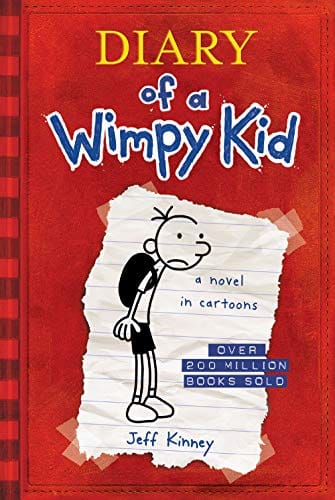Diary of a Wimpy Kid #1 – Summary, Themes & Reading Guide
Plot, characters, themes and age-appropriate reading tips for Diary of a Wimpy Kid #1, the hilarious illustrated novel by Jeff Kinney.

Introduction to Diary of a Wimpy Kid
“Diary of a Wimpy Kid (Diary of a Wimpy Kid #1)” by Jeff Kinney burst onto the children’s literature scene in 2007, turning everyday middle-school drama into laugh-out-loud comedy. Written as the illustrated journal of sixth-grader Greg Heffley, the novel combines lined-paper doodles with short, punchy entries that mirror the way real kids scribble in their notebooks. The result is a highly relatable, fast-paced read that invites even reluctant readers to keep turning pages. In roughly 800 words, this article explores the first book’s plot, characters, themes, and lasting influence while offering tips for parents and educators.
Plot Summary (Spoiler-Light)
The story opens on Greg’s first day of middle school, a place he immediately labels “a dumb idea” because it forces kids of wildly different sizes into one building. Armed with a sketchy plan to climb the social ladder, Greg chronicles his schemes—from auditioning for the school play to launching a doomed wrestling career—only to watch them backfire in spectacular fashion. His well-meaning but clueless best friend, Rowley Jefferson, often becomes collateral damage in Greg’s quest for popularity. Through Halloween pranks, the infamous Cheese Touch, and an ill-fated safety-patrol gig, Greg slowly learns that manipulating others rarely brings the fame he craves. By the final pages, he discovers that genuine friendship may be worth more than peer approval, though the lesson comes with plenty of comedic bumps and bruises.
Main Characters
Greg Heffley
Greg is an everyman anti-hero: self-centered yet strangely endearing. His shameless honesty about wanting to “be famous one day” gives readers a front-row seat to the awkward calculations kids make when navigating social hierarchies. Because Greg narrates the diary himself, we experience events filtered through his often unreliable perspective, which adds an extra layer of humor.
Rowley Jefferson
Rowley serves as Greg’s naïve foil. Enthusiastic, kind, and unbothered by popularity contests, he highlights just how far Greg is willing to go to look cool. Rowley’s sincerity makes him a fan favorite and eventually the moral compass that exposes Greg’s flaws.
The Heffley Family
Greg’s family members—practical Mom, sports-obsessed Dad, annoying younger brother Manny, and obnoxious older brother Rodrick—add domestic chaos. Their reactions to Greg’s antics often produce some of the book’s funniest moments, from Rodrick’s mockery to Mom’s well-meaning but embarrassing interventions.
Key Themes and Messages
Middle-School Survival
At its core, the novel explores how tweens cope with the sudden leap from child to adolescent. Lockers, cliques, and puberty form a pressure cooker that pushes Greg to make questionable choices, reflecting real-life student anxieties.
Friendship and Loyalty
Greg’s rocky relationship with Rowley demonstrates that loyalty is easier said than practiced. While Greg frequently puts friendship second to fame, Rowley’s forgiving nature shows young readers the power of empathy and second chances.
Consequences of Self-Centeredness
Through comical mishaps, the book subtly teaches that selfish behavior carries repercussions. Greg rarely gets away with his schemes, underscoring the importance of accountability without sounding preachy.
Jeff Kinney and the Series Origin
Jeff Kinney began “Diary of a Wimpy Kid” as a daily online serial on FunBrain.com, where it attracted millions of readers before becoming a print phenomenon. Kinney, who initially dreamed of creating a newspaper comic strip, blends cartoon art with prose to modernize the diary format popularized by classics like “Harriet the Spy.” The author’s knack for visual gags and comedic timing turned a single title into a franchise that now spans more than a dozen sequels, three live-action films, and multiple animated adaptations.
Cultural Impact and Popularity
Since publication, the first “Wimpy Kid” book has sold over 250 million copies worldwide and been translated into 65+ languages. Its success ushered in a wave of illustrated chapter books, influencing series such as “Dork Diaries” and “Big Nate.” Teachers praise the novel for bridging the gap between picture books and full-length fiction, while librarians report increased circulation among grade-school boys—an often hard-to-reach demographic. Moreover, the humor crosses age lines, allowing parents and kids to enjoy the story together.
Who Should Read Diary of a Wimpy Kid #1?
The target audience is ages 8–12, but the conversational style appeals to older readers nostalgic for the awkwardness of middle school. Educators can use the book to spark discussions about peer pressure, journal writing, and narrative perspective. For reluctant readers, the mix of cartoons and short paragraphs lowers the intimidation factor, making the novel an excellent entry point into longer works. Parents concerned about content can rest easy: the book contains mild mischief but no profanity or graphic material.
Final Thoughts
“Diary of a Wimpy Kid (Diary of a Wimpy Kid #1)” turns cringe-worthy adolescence into comedic gold while sneaking in valuable life lessons about friendship and integrity. Jeff Kinney’s blend of expressive illustrations and candid diary entries revolutionized children’s publishing and continues to captivate new generations. Whether you’re a parent hunting for an engaging read, a teacher building a classroom library, or an adult willing to relive the drama of lockers and lunch lines, the first “Wimpy Kid” book delivers laughs and insights in equal measure.



